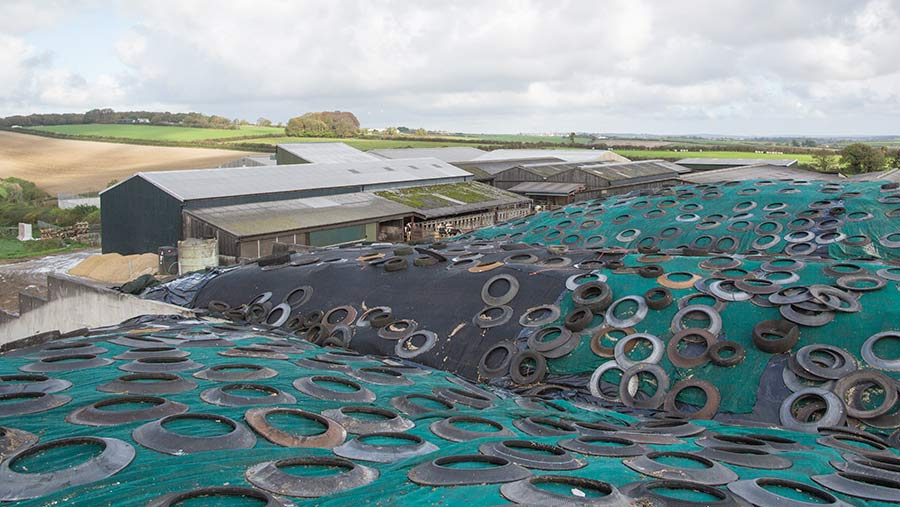Advice on cutting dairy ration costs this winter
 © Tim Scrivener
© Tim Scrivener Farmers could save money on purchased feed this winter by making the most of plentiful stocks of good-quality forages.
Analysis of first- and second-cut grass silage carried out by Trouw Nutrition GB shows that average protein and energy levels are good at 14.5% crude protein (CP) and 11.05 metabolisable energy (ME) (see table below).
Revealing the results at UK Dairy Day this week (12 September), Dr Liz Homer, ruminant technical development manager at Trouw, said winter feeding prospects were encouraging.
“Good weather and the adoption of multicut systems by many farmers mean that stocks are generally higher and the quality is looking very good,” she said.
“Together these should allow higher forage intakes, improved rumen performance and the potential to reduce purchased feed costs per litre.”
This will be welcome news for many farmers after last year’s dry conditions left them short of forage. As a result, they were forced to increase feed rates to replace forage, with Kite’s Cost of Production report showing that feed costs rose by 1.5ppl from 2018 to 2019.
Advice on supplementing forage
Quality has been sustained throughout the season and preliminary third-cut samples have analysed similarly to second-cut, which should make rationing easier.
Despite this, dry matter (DM) is higher at more than 33%, which can reduce intakes, and lignin levels are also high.
This is probable a result of crops being more mature at cutting due to continued growth during the winter. Rapid stem growth also promotes higher lignin, explained Dr Homer.
See also: 6 ways to reduce maize losses from harvest to feeding
Higher lignin content makes fibre less digestible, which could lead to reduced rumen passage rates and lower feed intakes unless the diet is not carefully balanced.
Dr Homer advised farmers to supplement forage with rapidly fermentable carbohydrates such as molasses and ground cereals, to make more space for forage by improving passage through the rumen.
Independent nutritionist Mark Price of Dairy Diagnostics said farmers also needed to be wary of higher NDF levels in silage this year.
“If you supplement with high NDF products you will get reduced milk yield because you will fill the cow up and not get enough rapidly fermentable carbohydrates into the rumen,” he explained.
Instead he said farmers should avoid supplementing forages with products higher in NDF such as wheat feed, soya hulls and biscuit meal in favour of cereals such as rolled wheat, molasses and ground maize.
With cereal prices having come down, he said this presented dairy producers with a good opportunity to reduce ration costs.
Despite this, nutritionists warn that there is a range in results around the country which means it is essential for farmers to analyse their own clamps at least once every month.
Clamp management advice
With bumper silage crops and many clamps already full, Mr Price, who is based in the Midlands, advised against overfilling.
“Make sure you’re not overfilling clamps. Bales are a good option if your clamp is full. Late season silage can be variable, even if it looks nice, so make it into bales. It means you can be flexible with how you feed it.
“Maize crops are looking very well and a lot of people haven’t got room for it. Consider Ag Bags if you have enough concrete or hard core. They are often overlooked and work very well.”
|
Silage averages to September 2019 |
|||||
|
|
Early first cut |
First cut |
Second cut |
Wholecrop |
|
|
Dry matter (%) |
34.1 |
33.3 |
34.8 |
37.8 |
|
|
Crude Protein (% DM) |
15.4 |
14.6 |
14.4 |
8.7 |
|
|
D Value (%) |
71.8 |
70.6 |
67.6 |
64.7 |
|
|
ME (MJ/kg DM) |
11.5 |
11.3 |
10.8 |
10.1 |
|
|
Starch (% DM) |
N/A |
N/A |
N/A |
27.2 |
|
|
NDF (% DM) |
45.8 |
47.4 |
49 |
45.8 |
|
|
Lignin (g/kg DM) |
35.2 |
36 |
37.7 |
45.8 |
|
|
Acid load |
49.8 |
48.6 |
46.3 |
52.3 |
|
|
Fibre Index |
183.8 |
189.9 |
197.1 |
188.8 |
|
|
DyNE (MJ/kg DM |
6.2 |
6.12 |
6 |
5.52 |
|
|
The results are for 4,500 samples of first cut, 1,000 samples of second and more than 500 wholecrop samples |
|||||
